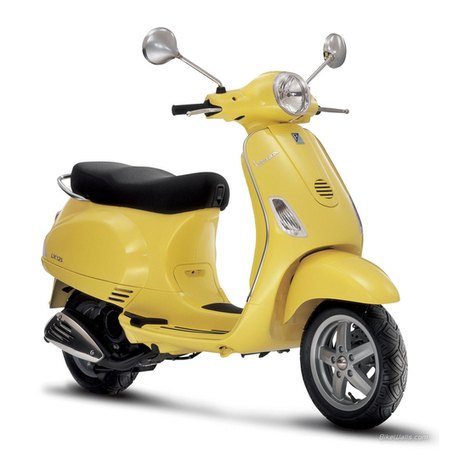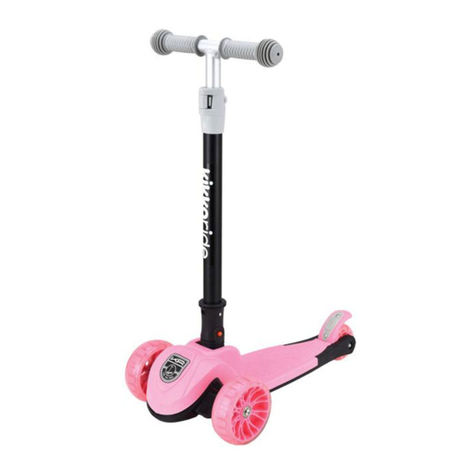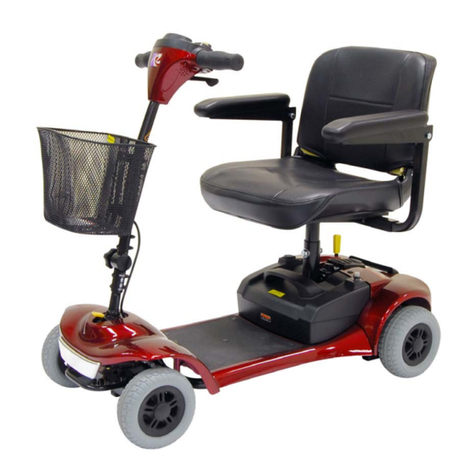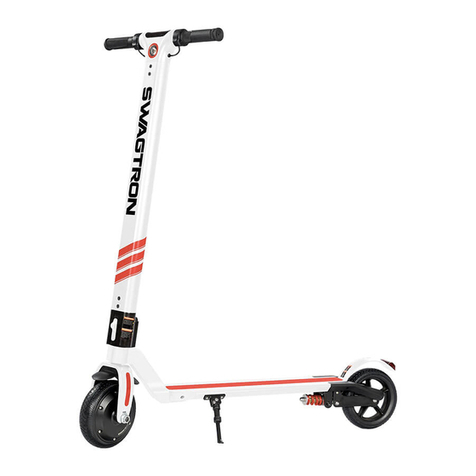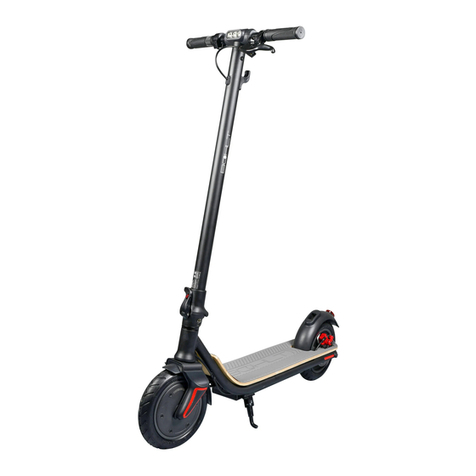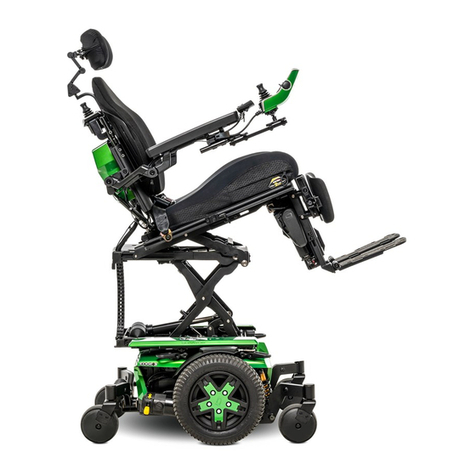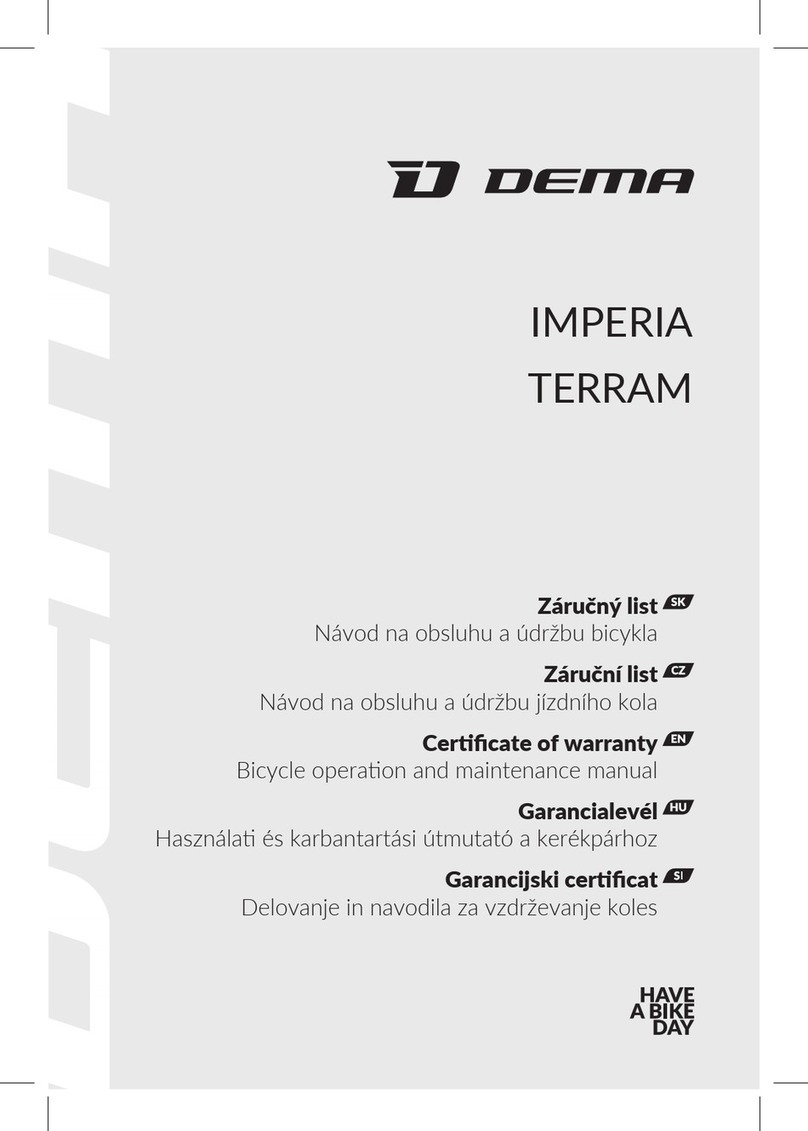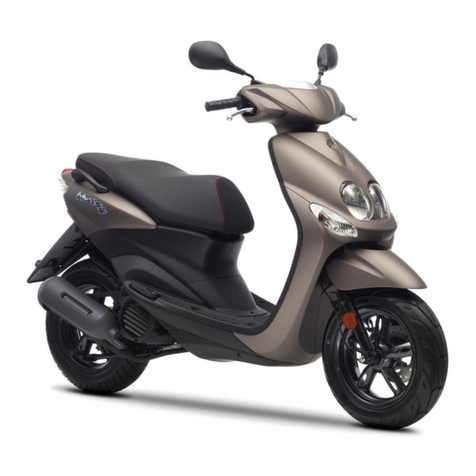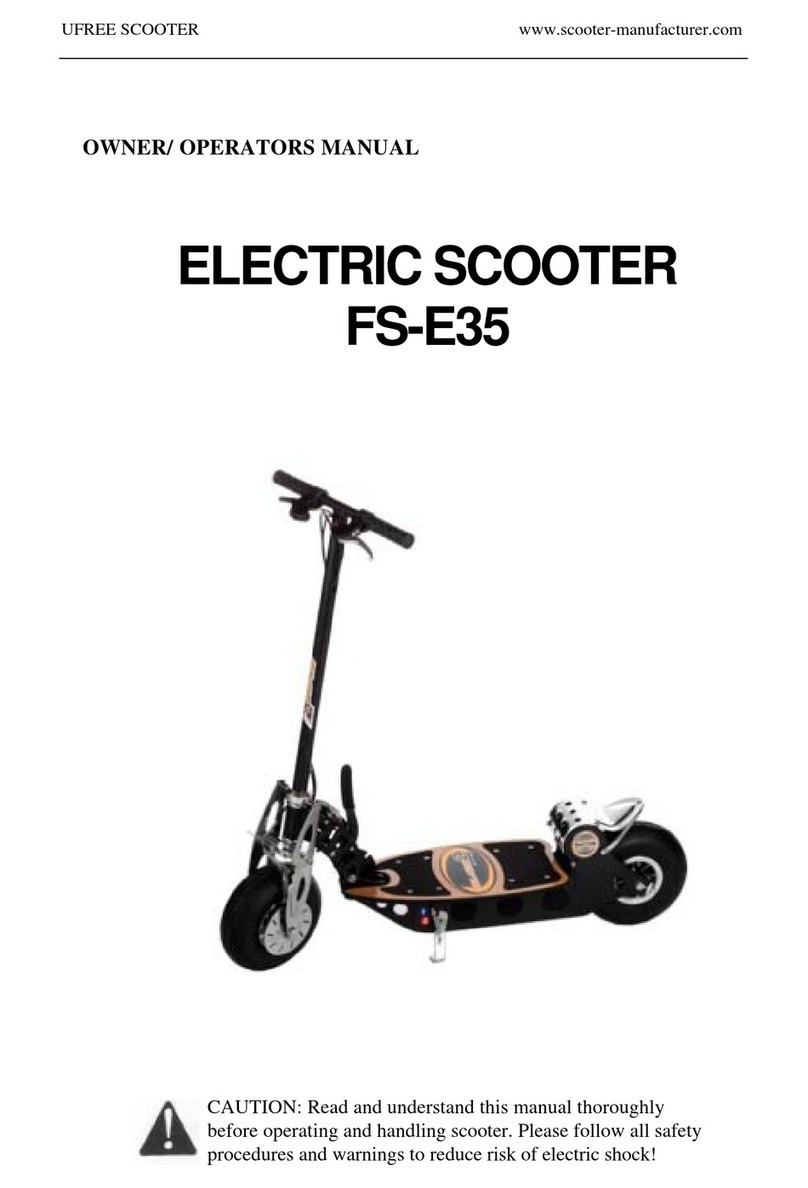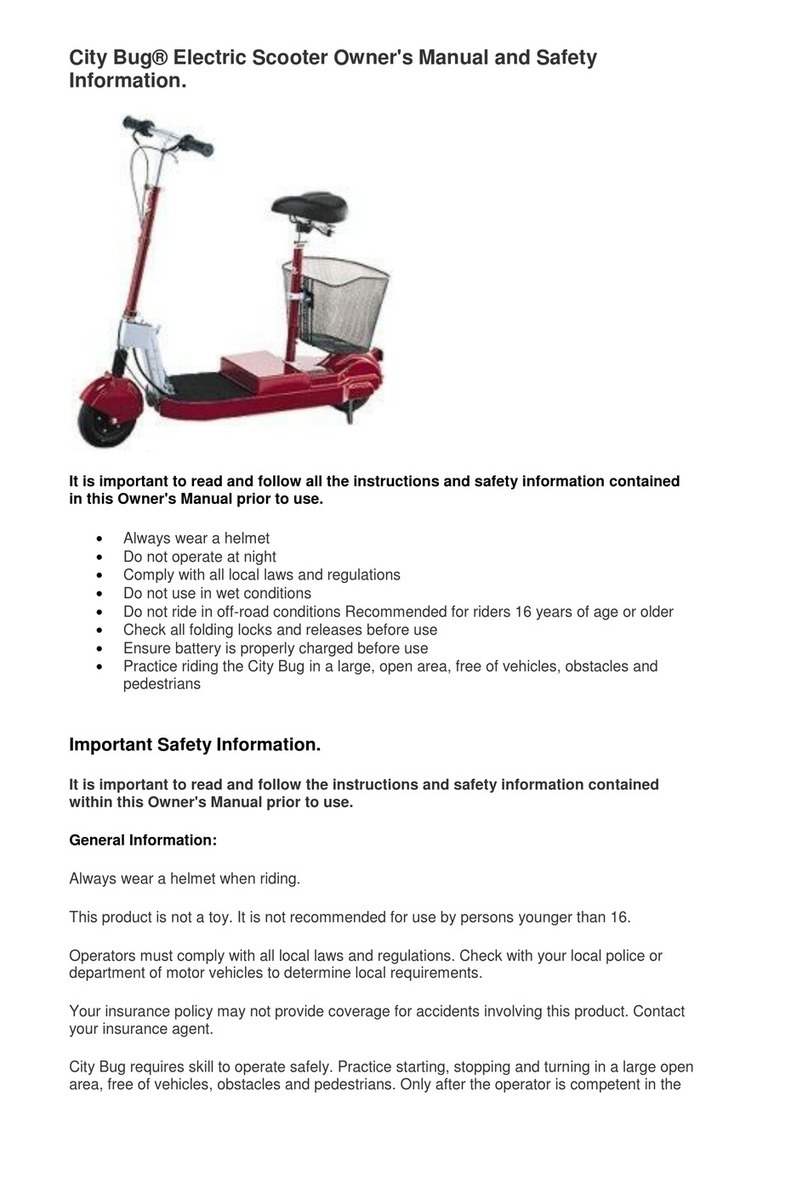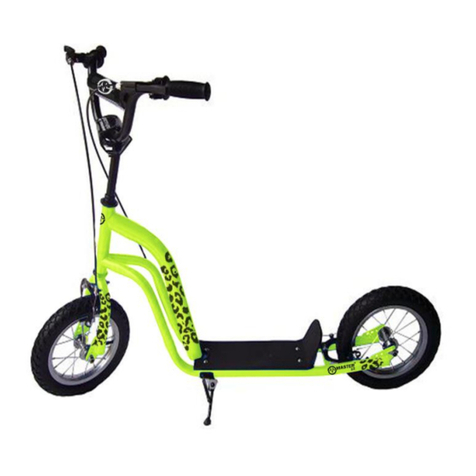Benelli CAFFENERO User manual

CAFFENERO
November 2017
!Details described or illustrated in this booklet may differ from the vehicle's actual specification
as purchased, the accessories fitted or the national-market specification. No claims will be
asserted as a result of such discrepancies.
Dimensions, weights, fuel consumption and performance data are quoted to the customary
tolerances.
The right to modify designs, equipment and accessories is reserved. Errors and omissions
excepted.

WARNING
!
TIP
WARNING
!
Please read this manual carefully and completely
before operating this vehicle.
These are the safety alert symbols. They are used to
alert you to potential personal injury hazards. Obey all
safety messages that follow this symbol to avoid
possible injury or death.
indicates a hazardous situa-
tion which, if not avoided,
could result in death or seri-
ous injury.
indicates special precautions
that must be taken to avoid
damage to the vehicle or other
property.
provides key information to
make procedures easier or
clearer.
1 - 2
Welcome to the world of scootering!
As the owner, you are benefiting from the vast experi-
ence and newest technology regarding the design
and manufacture of high-quality products, which have
earned us a reputation for dependability.
Please take the time to read this manual thoroughly,
so as to enjoy all advantages of your vehicle. The
Owner’s Manual does not only instruct you in how to
operate, inspect and maintain your vehicle, but also
how to safeguard yourself and others from trouble
and injury.
In addition, the many tips given in this manual will
help keep your vehicle in the best possible condition.
If you have any further questions, do not hesitate to
contact your dealer.
Our team wishes you many safe and pleasant rides.
So, remember to put safety first!
Our company continually seeks advancements in
product design and quality. Therefore, while this
manual contains the most current product information
available at the time of printing, there may be minor
discrepancies between your vehicle and this manual.
If there is any question concerning this manual,
please consult your dealer.
INTRODUCTION
IMPORTANT MANUAL
INFORMATION
NOTICE
INTRODUCTION
Safety information
● Safe-riding
● Further safe-riding tips
DESCRIPTION
● Left view
● Right view
● Controls and instruments
CONSUMER INFORMATION
● VIN and engine serial number
INSTRUMENTS AND CONTROL
FUNCTIONS
● Main switch/steering lock
● Meter & Indicator
● Handlebar
● Fuel Tank Switch & Fuel Tank
● Rear shock absorber
● Coolant level check
PRE-OPERATION CHECKS
OPERATION AND IMPORTANT
RIDING POINTS
● Starting the engine
● Acceleration and deceleration
● Braking
1
3
3
5
6
6
6
7
7
7
7
7
8
9
10
11
12
13
14
14
15
15
● Engine break-in
● Parking
PERIODIC MAINTENANCE AND
ADJUSTMENT
● Periodic maintenance chart
● Checking the spark plug
● Engine oil
● Idle speed
● Valve clearance
● Air filter
● Checking the throttle cable free play
● Checking the front brake lever and
rear brake lever free play
● Checking the brake pads
● Brake fluid
● Checking the battery
● Replacing the fuses and bulbs
TIRE
STORAGE
● Storage
SPECIFICATIONS
● Specification
15
16
16
17
19
19
21
21
21
22
22
23
23
24
25
25
26
27

Be a Responsible Owner
As the vehicle's owner, you are responsible for the
safe and proper operation of your vehicle.
The safe use and operation are dependent upon the
use of proper riding techniques as well as the exper-
tise of the operator. Every operator should know the
following requirements before riding this vehicle.
He or she should:
● Obtain thorough instructions from a competent
source on all aspects of vehicle operation.
● Observe the warnings and maintenance require-
ments in this Owner’s Manual.
● Obtain qualified training in safe and proper riding
techniques.
● Obtain professional technical service as indicated
in this Owner´s Manual and/or when made neces-
sary by mechanical conditions.
Safe Riding
Perform the pre-operation checks each time you
use the vehicle to make sure it is in safe operating
condition. Failure to inspect or maintain the vehicle
properly increases the possibility of an accident or
equipment damage. See the list of pre-operation
checks.
SAFETY INFORMATION
3 - 4
● This vehicle is designed to carry the operator and
a passenger.
● The failure of motorists to detect and recognize
vehicles in traffic is the predominating cause of
automobile/vehicle accidents. Many accidents have
been caused by an automobile driver who did not
see the vehicle. Making yourself prominent appears
to be very effective in reducing the chance of this
type of accident. Therefore:
• Wear a brightly colored jacket.
• Use extra caution when you are approaching
and passing through intersections, since intersec-
tions are the most likely places for vehicle accidents
to occur.
• Ride where other motorists can see you. Avoid
riding in another motorist’s blind spot.
● Many accidents involve inexperienced operators.
In fact, many operators who have been involved in
accidents do not even have a current driver´s
license.
• Make sure that you are qualified and that you only
lend your vehicle to other qualified operators.
• Know your skills and limits.
Staying within your limits may help you to avoid an
accident.
• We recommend that you practice riding your vehi-
cle where there is no traffic until you have become
thoroughly familiar with the vehicle and all of its con-
trols.
● Many accidents have been caused by error of the
vehicle operator. A typical error made by the operator
is veering wide on a turn due to excessive speed or
under-cornering (insufficient lean angle for the
speed).
• Always obey the speed limit and never travel faster
than the legal speed limit.
• Always signal before turning or changing lanes.
Make sure that other motorists can see you.
● The posture of the operator and passenger is
important for proper control.
• The operator should keep both hands on the han-
dlebar and both feet on the operator footrests during
operation to maintain control of the vehicle.
• The passenger should always hold onto the opera-
tor, the seat strap or grab bar, if equipped, with both
hands and keep both feet on the passenger foot-
rests. Never carry a passenger unless he or she can
firmly place both feet on the passenger footrests.
● Never ride under the influence of alcohol or other
drugs.
● This vehicle is designed for on-road use only. It is
not suitable for off-road use.
Protective apparel
The majority of fatalities from vehicle accidents are
the result of head injuries. The use of a safety helmet
is the most critical factor in the prevention or reduc-
tion of head injuries.
● Always wear an approved helmet.
● Wear a face shield or goggles.
Wind in your unprotected eyes could contribute to an
impairment of vision that could delay seeing a
hazard.
● The use of a jacket, substantial shoes, trousers,
gloves, etc., is effective in preventing or reducing
abrasions or lacerations.
● Never wear loose-fitting clothes, otherwise they
could catch on the control levers or wheels and
cause injury or an accident.
● A passenger should also observe the above pre-
cautions.
Avoid Carbon Monoxide Poisoning.
All engine exhaust contains carbon-monoxide, a
deadly gas. Breathing carbon monoxide can cause
headaches, dizziness, drowsiness, nausea confu-
sion, and eventually death.
Carbon Monoxide is a colorless, odorless, tasteless
gas which may be present even if you do not see or
smell any engine exhaust. Deadly levels of carbon
monoxide can collect rapidly and you can quickly be
overcome and unable to save yourself. Also, deadly
levels of carbon monoxide can linger for hours or

5 - 6
days in enclosed or poorly ventilated areas. If you
experience any symptoms of carbon monoxide poi-
soning, leave the area immediately, get fresh air, and
seek medical treatment.
● Do not run engine indoors. Even if you try to venti-
late engine exhaust with fans or open windows and
doors, carbon monoxide can rapidly reach danger-
ous levels.
● Do not run engine in poorly ventilated or partially
enclosed areas such as barns, garages.
● Do not run engine outdoors where engine exhaust
can be drawn into a building through openings such
as windows and doors.
Further safe-riding points
● Be sure to signal clearly when making turns.
● Braking can be extremely difficult on a wet road.
Avoid hard braking, because the vehicle could slide.
Apply the brakes slowly when stopping on a wet sur-
face.
● Slow down as you approach a corner or turn. Once
you have completed a turn, accelerate slowly.
● Be careful when passing parked cars. A driver
might not see you and open a door in your path.
● Railroad crossings, streetcar rails, iron plates on
road construction sites,and manhole covers become
extremely slippery when wet. Slow down and cross
them with caution. Keep the vehicle upright, other-
wise it could slide out .
● The brake pads could get wet when you wash the
vehicle. After washing the vehicle, check the brakes
before riding.
● Always wear a helmet, gloves, trousers (tapered
around the cuff and ankle so they do not flap), and a
bright colored jacket.
● Do not carry too much luggage on the vehicle. An
overloaded vehicle is unstable. Use a strong cord to
secure any luggage to the carrier (if equipped). A
loose load will affect the stability of the vehicle and
could divert your attention from the road.
● Do not overload the rear carrier, the glove box or
the underseat storage box.
Always wear protective clothing that covers your
legs, ankles, and feet. The engine or exhaust sys-
tem become very hot during or after operation and
can cause burns. Let the engine and exhaust system
cool before touching it.
DESCRIPTION Left view
Right view
1 Front brake lever
2 Left handlebar switch
3 Meter
7 Fuel tank
8 Glove box
9 Center stand
10 Side stand
4 Right handlebar switch
6 Rear brake lever
5 Throttle grip
8
7
9
10
1
2
3
5
4
6
WARNING
!

7 - 8
TIP
CONSUMER INFORMATION
The vehicle identifi-
cation number / the
engine serial
number are used to
register the vehi-
cle,they are also
used to assist your
dealer in terms of
ordering parts or
referring to special
service information.
Meter & Indicator
engine serial number
●The vehicle identifi-
cation number ① is
behind a plastic cover
stamped into the
center frame support.
● The engine serial
number ② is stamped
on the rear, left side of
the engine behind the
airbox next to the rear
brake caliper.
VIN No.
ENGINE No.
INSTRUMENT AND CONTROL
FUNCTIONS
“ ”(Off)position:
All the circuits are off.
“ ”(On) position:
The circuits are on.
“ ”(Parking): (IF EQUIPPED)
The taillight, license plate light and auxiliary lights
are on. The hazard lights and turn signal lights can
be turned on, but all other electrical systems are off.
The key can be removed.
“ ” (The steering lock)
Turn the steering handle to left, press the key inward
to “ ” position, the steering lock is locked. When it
needs to open, insert the key and turn to “ ” posi-
tion, the steering lock is released.
P
Do not turn your key to lock the vehicle while
driving which is not necessary and is also apt to
cause an accident.
Press the key in with proper force.
NOTICE
Vehicle identification number
( VIN )
P
U
S
H
1. TACHOMETER
Tachometer indicates the revolution per minute of engine.
2. ADJUST BUTTON
Short press the button to switch between km/h and mph.
Long press the button to reset the "Trip" mileage.
3. SELECT BUTTON
Short press the button to switch between trip and odome-
ter functions on the meter. Press button “SELECT” for sev-
eral seconds, there will appear the interface for time
adjustment: “SELECT” for selection of digits of time
display and “ADJUST” for adjustment of each value.
4. FUEL LEVEL INDICATOR:
It indicates the fuel level in the fuel tank.
8. ENGINE CONTROL SYSTEM TROUBLE INDICA-
TOR:
Return to an authorized dealer if this indicator is acti-
vated during riding.
9. SPEEDOMETER
Speedometer shows the speed, hours/kilometers/miles.
10. ODOMETER & TRIP METER:
Relative mileage (TRIP): it records the mileage the vehicle
covers in a period of time. Odometer (TOTAL): it records the
total mileage the vehicle has covered in km or miles.
11. CLOCK
Indicates the time.
5. TURNING INDICATOR
The indication lamps will flash
with the turning signals.
6. HIGH BEAM INDICATOR
LAMP
When the high beam lamp of the
headlamp turns on, the high beam
indicator lamp will be on.
7. LOW OIL WARNING LAMP
When the engine is low on or out
of oil this lamp is activated. Shut
off the engine immediately if acti-
vated.
1
2

Turn the switch to " " position, the high beam of
the headlamp will turn on and the indicator lamp on
the meter will also turn on; turn the switch to " "
position, the low beam of the headlamp will turn on.
Direction indicator lamp switch
Turn the switch to " " position, the left direction
signal lamp flashes; turn the switch to " " position,
the right direction signal lamp flashes. And the indi-
cator lamps will turn on accordingly.
When the switch is on " " position and the power
is on, the engine runs.
When the switch is on " " position the power is off
and the engine cannot be started.
WARNING
!
Turn on the direction signal lamps in time when
changing lanes or turning a direction, turn off
the lamps when turning is complete.
Under normal conditions, this switch shall be on
"Operate" ( ) position. Use this switch during
emergency situations, for example accident or
key switch problems.
NOTICE
9 - 10
Dimmer switch
Press in the button, to activate the horn.
Horn button
Engine stop switch
When starting the engine, pull the front or rear brake
lever to cut off driving of the rear wheel and so the
engine will start.
Brake lever switch
When passing other vehicles, press this button so
the high beams of the headlamp will flash to alarm
the vehicles in front of you.
Passing switch
Pull the front or rear brake lever and press the
button to run the electric motor and start the engine.
Electric starter button
Pull the brake lever properly to use the front brake.
Do not pull the lever too abruptly or hard.
Front brake lever
Throttle grip is used to control the speed of the
engine. Twist the grip towards yourself to rev up or
turn it in the opposite direction to slow down.
Throttle grip
Turn to “ ” and the four direction signal lamps will
flash to warn for an emergency situation; turn to "●"
for daytime driving.
Hazard Switch
HANDLEBAR
2. High/Low switch “ / ”
1. Passing switch
3. Direction indicator lamp switch “ / ”
4. Horn switch “ ”
2. Hazard Light Switch “ ”
1. Engine stop switch“ / ”
3. Electric starter button “ ”
LEFT HANDLEBAR
RIGHT HANDLEBAR
FUEL TANK
To open the fuel tank cap, insert the key into the lock
on the left side of the scooter and turn it clockwise to
unlock the seat. Once the seat is open turn the cap
counterclockwise to remove it. To close the fuel tank,
replace the cap and then close the seat.
2
1
3
4
2
1
3

11 - 12
REAR SHOCK ABSORBERS COOLANT LEVEL INSPECTION
The rear shock absorbers are equipped with a spring
preload adjusting ring. The preload of the rear
shocks can be adjusted in compliance with the driv-
er's weight and loading condition, driving method
and road conditions. Adjust when vehicle is stable
on the main stand or side stand, turn the preload
ring to the place required.
To check the coolant level:
1. Use the key to open the glove box
2. Shine a flashlight into the front legshield area next
to the front fender to illuminate the coolant reservoir.
3. The reservoir is marked with a H (High) and L
(Low) level marking. If the fluid level is low add cool-
ant until it reaches the H mark.
4. To add fluid, remove the two phillips screws from
the access panel on the upper left side of the leg
shield underneath the left handlebar.
5. Replace the rubber cap once fluid is added.
WARNING
!
Do not over fill the fuel tank. Do not allow fuel to
splash on the hot engine.
Please stop the engine and turn the ignition key
to " " (Off) position when you need to refuel.
Do not forget to reinstall the fuel tank cap after
adding fuel in case of evaporation to the air,
which is a waste of energy and would pollute
the environment. Don't use fire when refueling.
Recommended fuel:
91 OCTANE UNLEADED
GASOLINE ONLY
Fuel tank capacity:
2 Gallons
TORQUE VALUE
Upper fixing bolt: 37-44N.m
Lower fixing bolt: 22-29N.m
Adjustable
SOFTERSOFTER
STIFFER
STIFFER
ADJUSTER
ADJUSTER
COOLANT
RESERVOIR
HIGH LEVEL
MARK
COOLANT
RESERVOIR
HIGH LEVEL
MARK
COOLANT
RESERVOIR
CAP
COOLANT
RESERVOIR
CAP

PRE-OPERATION CHECKS
Inspect your vehicle each time you use it to make
sure the vehicle is in a safe operating condition.
Always follow the inspection and maintenance pro-
cedures and schedules described in the Owner's
Manual.
Before using this vehicle, check the following points:
STARTING THE ENGINE
1. Turn the key to the “ON” position.
2. Pull in the front or rear brake lever to deactivate the
lock out system.
3. Start the engine by pushing the start switch.
Read the Owner’s Manual carefully to become
familiar with all of the controls. If there is a control or
function you do not understand, ask your dealer.
OPERATION AND IMPORTANT
RIDING TIPS
WARNING
!
Failure to inspect or maintain the vehicle prop-
erly increases the possibility of an accident or
equipment damage. Do not operate the vehicle if
you find any problems. If a problem cannot be
corrected by the procedures provided in this
manual, have the vehicle inspected by a dealer.
WARNING
!
Failure to familiarize yourself with the controls
can lead to loss of control, which could cause an
accident or injury.
WARNING
!
Do not start the engine indoors with bad ventila-
tion or without ventilation. Do not leave a start-
ing vehicle running when no one else is around.
Do not rev the vehicle to high engine RPM's
when it is not being ridden, this could cause the
engine to overheat and damage it's internal
parts.
NOTICE
13 - 14
ITEM CHECKS
Fuel • Check fuel level in fuel tank.
• Refuel if necessary.
• Check fuel line for leakage
Engine oil • Check oil level in engine.
• If necessary, add recommended oil
to specified level.
• Check vehicle for oil leakage.
ITEM CHECKS
Disc brakes • Check operation.
• If soft or spongy, have dealer bleed
hydraulic system.
• Check brake pads for wear. Replace
if necessary.
• Check fluid level in reservoir. If
necessary, add recommended brake
fluid to specified level.
• Check hydraulic system for leakage.
ITEM CHECKS
Wheels and tires • Check for damage.
• Check tire condition and tread depth.
• Check air pressure.
Brake levers • Make sure that operation is smooth.
• Lubricate pivots if necessary.
Sidestand,
Mainstand
• Lubricate pivots if necessary.
Instruments,
lights, signals
and switches
• Check operation.
Drum brake
( If equipped )
• Check operation.
• Check brake shoes for wear. Replace
if necessary.
Throttle grip • Make sure that operation is smooth.
• Check cable free play.
• If necessary, have a dealer adjust
cable free play and lubricate cable
and grip housing.
Throttle cable • Make sure that operation is smooth.
• Check cable free play.
• If necessary, have a dealer adjust
cable free play and lubricate cable.

The speed can be adjusted by opening and closing
the throttle. To increase the speed, turn the throttle
grip in direction (a). To reduce the speed, turn the
throttle grip in direction (b).
WARNING
!
It is dangerous to only use either the front brake
or rear brake which may cause skidding or loss
of control. Be careful and use the brakes proper-
ly when you drive on wet or curved roads.
WARNING
!
Failure to properly maintain the vehicle or
performing maintenance activities incorrectly
may increase your risk of injury or death during
service or while using the vehicle. If you are not
familiar with vehicle service, have a dealer
perform the needed service.
● The annual checks must be performed every
year, except if a mileage-based maintenance is
performed instead.
● The vehicle may have different accessory for
different market and some parts may not exist
for common chart.
NOTICE
15 - 16
ACCELERATION AND DECELERATION
There is never a more important period in the life
of your engine than the period between 0 and 600
miles. For this reason, you should read the following
material carefully. Since the engine is brand new, do
not put an excessive load on it for the first 600 miles.
The various parts in the engine wear and fit to the
correct operating clearances. During this period,
avoid prolonged full-throttle operation or any condi-
tion that might result in engine overheating. The
engine should not be over revved and all the gears
shall not be over 80% of red zone engine rpm; don't
operate the throttle under a fully open position;
change the gears in time to keep the engine rpm in a
1. The vehicle should be parked on a firm and flat
surface.
2. Turn the power key to the position " " to stop
the engine.
3. Remove the ignition key from the switch after lock-
ing for security reasons.
ENGINE BREAK-IN
PARKING
Periodic inspection, adjustment, and lubrication will
keep your vehicle in the safest and most efficient
condition possible. Safety is an obligation of the
PERIODIC MAINTENANCE AND
ADJUSTMENT
1. Close the throttle completely.
2. Apply both front and rear brakes simultaneously to
keep the front end from diving while braking.
BRAKING
vehicle owner/operator. The most important points of
vehicle inspection, adjustment, and lubrication are
explained on the following pages. The intervals given
in the periodic maintenance and lubrication chart
should be considered as a general guide under
normal riding conditions. However, depending on the
weather, terrain, geographical location, and individu-
al use, the maintenance intervals may need to be
shortened.
reasonable range. It is strongly suggested to use the
vehicle very carefully during its running in period.
a
b

15 - 16 17 - 18
PERIODIC MAINTENANCE CHART
ITEM
●●●●●●
●●●●●●
●●●●●●
●●●●●●
●●●●●
●●●
●
●●●
●●
●
●●●●
●
●
●
●
●
●
●●●●●●
●●●●●●
●●●●●●
●●●●●●
●●
Rear brake lever
pivot shaft • Lubricate with silicone grease.
Side stand • Check operation.
• Lubricate.
Front fork • Check operation and oil leakage.
Shock absorber • Check operation and shock absorber for oil leakage.
Engine oil • Change.
• Check oil level and vehicle for oil leakage.
Engine oil strainer • Clean.
Front and rear brake
switches • Check operation.
Moving parts and
cables • Lubricate.
Throttle grip
Housing and cable
• Check operation and free play.
• Adjust the throttle cable free play if necessary.
Lights, signals
and switches
• Check operation.
• Adjust headlight beam.
CHECKS ODOMETER READING
600mi 3000mi 5500mi 8000mi 10500mi 13000mi
ITEM
Fuel line ●●
●●
●
●●●
●●●
●●●●●●
●●●●●●
●●●●●●
IR
●●●
●●●
●●●●●●
●
●●
●●
• Check fuel hoses for cracks or damage
Spark plug • Check condition. Clean and regap.
• Replace
Valves • Check/adjust valve clearance.
Air filter element • Inspect/cleaning/replace
• Check operation, fluid level and vehicle for fluid leakage.
• Inspect/replace brake pads.
Disc brake
Clutch shoe abrasion • Inspect/replace clutch shoes.
Tires
Transmission Belt
• Check tread depth and damage. (replace as needed)
• Check air pressure.
• I = Inspect / R = Replace
Wheels • Check runout and damage.
Chassis fasteners • Make sure that all nuts, bolts and screws are
properly tightened
●●●
Front brake lever
pivot shaft • Lubricate with silicone grease.
CHECKS ODOMETER READING
600mi 3000mi 5500mi 8000mi 10500mi 13000mi
New 3 months 6 months 9 months 15 months1 year New 3 months 6 months 9 months 15 months1 year

The engine oil should be between the minimum
and maximum level marks.
NOTICE
19 - 20
The spark plug is an important engine component,
which should be checked periodically, preferably by
a dealer. Since heat and deposits will cause any
spark plug to slowly erode, it should be removed and
checked in accordance with periodic maintenance. In
addition, the condition of the spark plug can reveal
the condition of the engine.
The porcelain insulator around the center electrode
of the spark plug should be a medium-to-light tan
(the ideal color when the vehicle is ridden normally).
If the spark plug shows a distinctly different color, the
engine could be operating improperly. Do not attempt
to diagnose such problems yourself. Instead, have a
dealer check the vehicle.
If the spark plug shows signs of electrode erosion
and excessive carbon or other deposits, it should be
replaced.
Before installing a new spark plug, the spark plug
gap should be measured with a thickness gauge
and, if necessary, adjusted to specification.
Clean the surface of the spark plug gasket and its
mating surface, and then wipe off any grime from
the spark plug threads.
CHECKING THE SPARK PLUG
The engine oil level should be checked before each
ride. In addition, the oil must be changed at the inter-
vals specified in the periodic maintenance and lubri-
cation chart.
ENGINE OIL
1. Start the engine, warm it up for several minutes,
and then turn it off.
TO CHECK THE ENGINE OIL LEVEL
1. Start the engine, warm it up for several minutes,
and then turn it off.
2. Place an oil pan under the engine to collect the
used oil.
3. Remove the engine oil filler cap and the engine oil
drain bolt to drain the oil from the crankcase.
4. Install the o-ring, screen, spring and the engine oil
drain bolt, and then tighten the drain bolt to the spec-
ified torque.
5. Refill with the specified amount of the recom-
mended engine oil, and then install and tighten the
oil filler cap.
TO CHANGE THE ENGINE OIL
GAP
Type
Gap
BOSCH UR2CC
or
NGK CR8E
0.5 - 0.7mm
2. Wait a few minutes until the oil settles.
3. Place the vehicle on the center stand. Inspect the
engine oil level using the dipstick on the right side of
the engine, remove and clean it then reinsert it to
read the oil level.
4. If the engine oil is below the minimum level mark,
add sufficient oil of the recommended type to refill it
to the correct level.
Type
API SH, SAE10W-40, JASO MA
Capacity After Draining
0.8 ± 0.05L

21 - 22
The air filter element should be replaced and should
be cleaned at the intervals specified in the periodic
maintenance and lubrication chart.
1. The air filter is located in the airbox on the left side
rear of the scooter next to the rear wheel.
2. Park the vehicle on firm ground.
3. Remove the air filter case cover by removing the
screws.
4. Pull the air filter element out.
5. Insert a new air filter element into the air filter
case.
6. Install the air filter case cover by reinstalling the
screws.
AIR FILTER
REPLACING THE AIR FILTER ELEMENT
The throttle cable free play should measure
2.0–6.0mm at the throttle grip. Periodically check the
throttle cable free play and, if necessary, have a
dealer adjust it.
CHECKING THE THROTTLE CABLE
FREE PLAY
The front and rear brake lever free play should mea-
sure 10-20mm as shown. Periodically check the
brake lever free play and, if necessary, have a dealer
check the brake system. The brake fluid should be
replaced at minimum every 2 years. Use only DOT 4
brake fluid from a sealed container when adding or
changing the brake fluid.
CHECKING THE FRONT BRAKE LEVER AND
REAR BRAKE LEVER FREE PLAY
Only use good quality fuel from a gasoline station to
prevent the fuel from clogging the fuel pump strainer,
or even the injector.
The engine is required to be at normal operating
temperature for an accurate idle adjustment.
IDLE SPEED
1. Keep the vehicle on a flat surface.
2. Start the engine and let it warm up for several
minutes.
3. Clip a digital Tachometer to the spark plug cable.
4. If the idle speed is not within the correct range,
contact the nearest authorized dealer.
IDLE ADJUSTMENT
The valve clearance changes with use, resulting in
improper air-fuel mixture and/or engine noise. To
prevent this from occurring, the valve clearance must
be adjusted by a dealer at the intervals specified in
the periodic maintenance and lubrication chart.
The engine is required to be cold to perform an
accurate valve clearance adjustment.
VALVE CLEARANCE
Idle speed: 1,400±100r/min
IN: 0.15mm EX: 0.15mm
Valve clearance ( Cold engine )
Disc Brake: Not spongy
A
B: Air Filter
B
A: Air Filter cover
Screws

23 - 24
WARNING
!
Do not use a fuse or bulb of a higher amperage
rating than recommended to avoid causing
extensive damage to the electrical system and
possibly a fire or other problems.
The front and rear brake pads must be checked for
wear at the intervals specified in the periodic mainte-
nance and lubrication chart.
Each brake pad is provided with wear indicator
grooves, which allow you to check the brake pad
wear without having to disassemble the brake. To
check the brake pad wear, check the wear indicator
grooves. If a brake pad has worn to the point that the
wear indicator grooves have mostly disappeared,
have a dealer replace the brake pads as a set.
CHECKING THE BRAKE PADS
Indicator
The brake system is serviced before delivery. Con-
tact your dealer if any problems occur.
Don't forget to check the fluid level in the brake fluid
reservoir. Add appropriate brake fluid if necessary.
BRAKE FLUID
Recommended brake fluid
DOT 4
WARNING
!
If brake fluid is ingested by mistake or contacts
eyes or skin, wash with a large amount of water,
and seek medical advice immediately.
Minimum level mark
LOWER
Minimum level mark
LOWER
Front Brake Fluid
Minimum level mark
Rear Brake Fluid
Minimum level mark
REPLACING THE FUSES AND BULBS
If a fuse or bulb for the individual circuits is blown,
replace it as follows.
1. Turn the key to “OFF” and turn off the electrical
circuit in question.
2. Remove the blown fuse or bulb, and then install a
new fuse or bulb of the specified type.
NORMAL
30A
30A
EFI System Fuse
Main Fuse
DAMAGED
CHECKING THE BATTERY
WARNING
!
The battery will produce explosive gas, beware of
using open flames or sparks near the battery. Your
battery is sealed and should not be opened at any
time. The battery contains sulfuric acid (electrolyte)
which can cause eye damage or skin burns.
Your battery is prefilled and activated from your
dealer. There is no need to add electrolyte, your bat-
tery is sealed and should not be opened for any
reason. Have a dealer charge the battery as soon as
possible if it seems to have discharged. Keep in
mind that the battery tends to discharge more quickly
if the vehicle is equipped with optional electrical
accessories.
12V6Ah(YTX7A-BS)
MF (Maintenance Free) Battery

25 - 26
STORAGE
Always store your vehicle in a cool, dry place and, if
necessary, protect it against dust with a porous
cover.
Remove the fill/oil level check bolt to check the final
drive fluid level, if full, oil should just barely leak from
the hole, if no fluid leaks out, fill the case with GL-5
85/90 hypoid gear oil until the level reaches the oil
level check hole and begins to leak out. DO NOT
lose the sealing washer or it will leak.
The final drive fluid should be checked and changed
at the intervals specified in the periodic maintenance
and lubrication chart.
See image on opposite page for details.
Short-term
Long-term
Inflation pressure and tire tread should be regularly
checked. In order to ensure maximum safety and
longer service life, inflation pressure requires more
frequent routine check.
Tire Pressure
Insufficient tire pressure will not only accelerate
wear, but also will have a bad impact on driving sta-
bility such as making turning difficult. However, too
much pressure will reduce the contact area between
the tire and ground, thus causing slipping or even
getting out of control. Tire pressure should be kept in
TIRES
FINAL DRIVE FLUID
the standard range. Adjust the tire pressure under a
"cold" condition.
TIRE INFORMATION
COLD TIRE PRESSURE
[FRONT] 33psi (2.25kgf/cm
2
) [REAR] 33psi (2.25kgf/cm
2
)
H7 12V 35W
12V 2W
12V 3A
12V 10/12V 16W
12V 5W
12V 5/21W
Turn light
Headlight bulb
Horn
Meter Light
Taillight bulb
City light
Capacity After Draining
0.13L ± 0.05L
XOX
Before storing your vehicle for several months:
1. Change the engine oil.
2. Drain the fuel from the fuel tank. Reinstall the fuel
tank cap.
3. Remove the spark plug and add one teaspoon of
(15~20cm3) clean engine oil to the cylinder, then
reinstall the spark plug again.
4. Remove the battery. Keep the battery in a cool
place which can avoid freezing and direct sunlight.
Charge the battery or examine the electrolyte level (if
equipped with lead-acid battery) often.
5. Clean and dry the vehicle. Wax the surface of the
paint.
6. Inflate tires to the required pressure. Put the vehi-
cle on a stand to keep the tires off the ground.
7. Cover the vehicle (no plastic or coating material)
and keep it in a place of consistent temperature and
low humidity. Do not keep your vehicle under direct
sunlight.
To use the vehicle after storage:
1. Remove the cover and clean the vehicle. Change
the engine oil if you stored your vehicle for more
than four months.
2. Examine the electrolyte level and charge as
needed. Install the battery.
3. Wash away the anti-rust agent in fuel tank (if
applied), and add fresh gasoline into the fuel tank.

SPECIFICATIONS NOTES
Size and Weight
Length
Width
Height
Wheelbase
Dry Weight
Engine
Type
Model
Bore × Stroke
Displacement
Ignition System Type
Compression Ratio
Maximum Power
Shifting Method
Clutch Type
Starting Method
.................................................................................
.......................................................................................................................................................................................................................................
.......................................................................................................................................................................................................................................
.......................................................................................................................................................................................................................................
.......................................................................................................................................................................................................................................
.......................................................................................................................................................................................................................................
.......................................................................................................................................................................................................................................
.......................................................................................................................................................................................................................................
.......................................................................................................................................................................................................................................
.......................................................................................................................................................................................................................................
.......................................................................................................................................................................................................................................
.......................................................................................
....................................................................................
...............................................................................
.........................................................................
.......................
.................................................................................
........................................................
.....................................................................
...............................................................
.................................................................
.........................................
............................................
..................................................
....................................................
Tire
81.5 in.
29 in.
48 in.
54 in.
286 lbs.
Single-cylinder, Four-stroke, Liquid-cooled
158MJ-A
ø57.5×57.8mm
150.1cc
TLI
11:1
12.87hp@7500r/min
V-Belt Transmission
Dry Centrifugal Type
Electric Starting
Front tire
Rear tire
Fuel Tank (include reserve tank)
Fuel Type
Front Brake Type
Rear Brake Type
Rated Max Load
110/80-16
120/80-16
2 gal
91-octane unleaded gasoline only
Disc Brake
Disc Brake
330 lbs.
......................................................................
.......................................................................
.......................................
............................
.......................................................
.....................................................
..............................................................
Fuel
Brake
Load
Maximum Torque 9.81 lbf.ft@6000r/min
....................................
Oil Capacity 0.8 L
............................................................................
This manual suits for next models
1
Table of contents
Other Benelli Scooter manuals
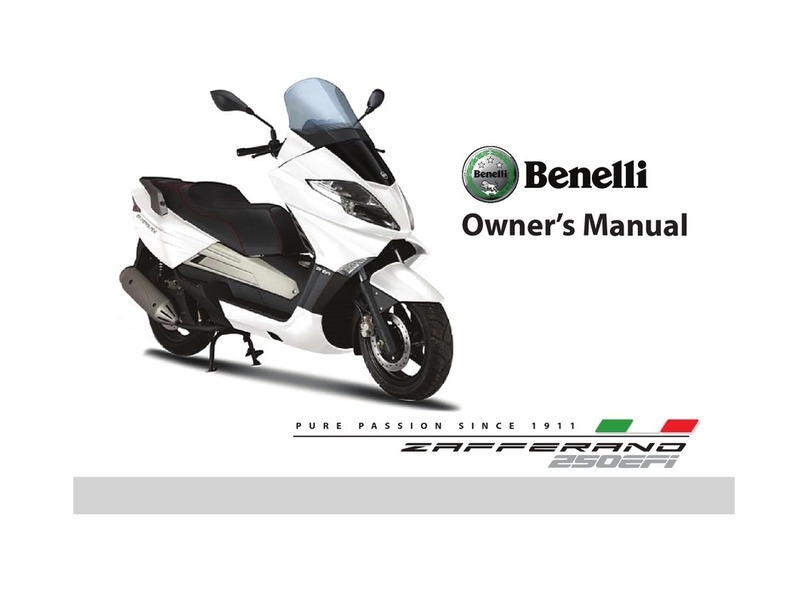
Benelli
Benelli ZAFFERANO 250EFI User manual
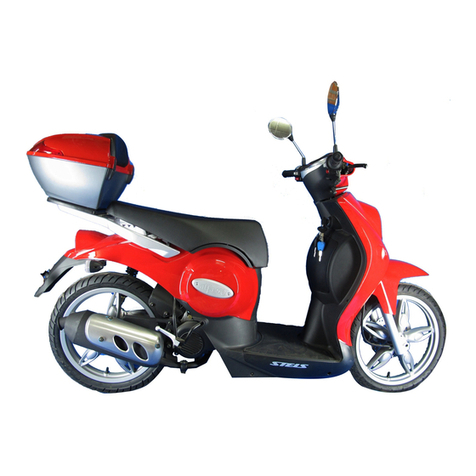
Benelli
Benelli Pepe User manual

Benelli
Benelli ZAFFERAN 250 User manual
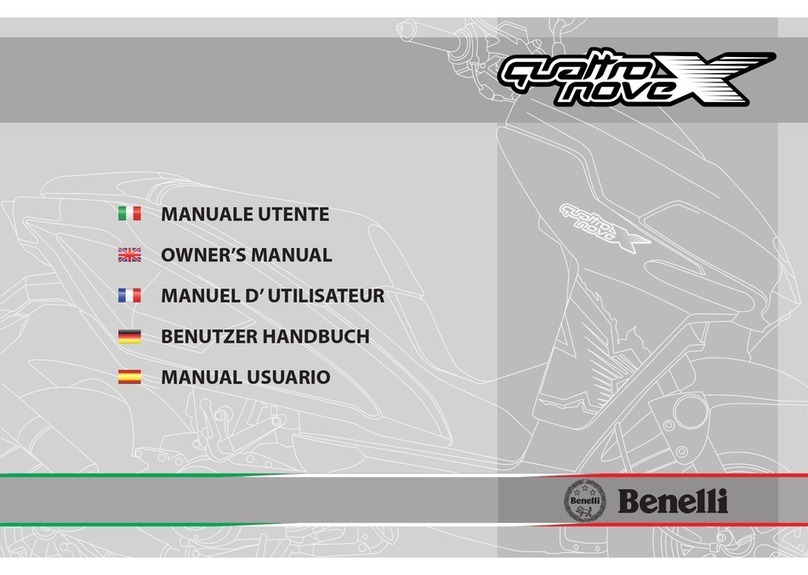
Benelli
Benelli qattronove x User manual
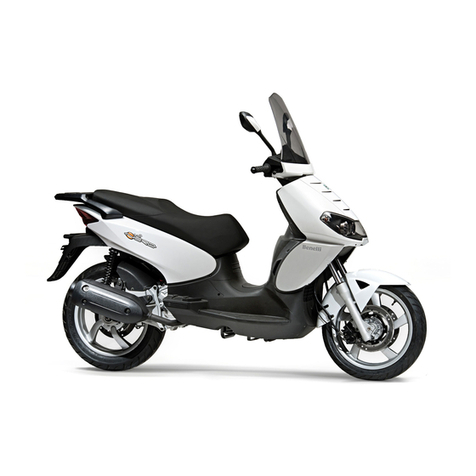
Benelli
Benelli macis User manual

Benelli
Benelli Velvet User manual
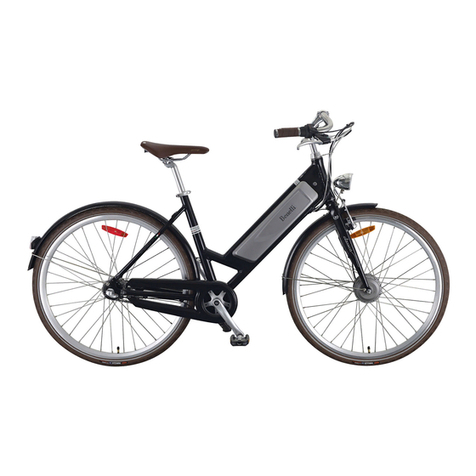
Benelli
Benelli CLASSICA28 User manual
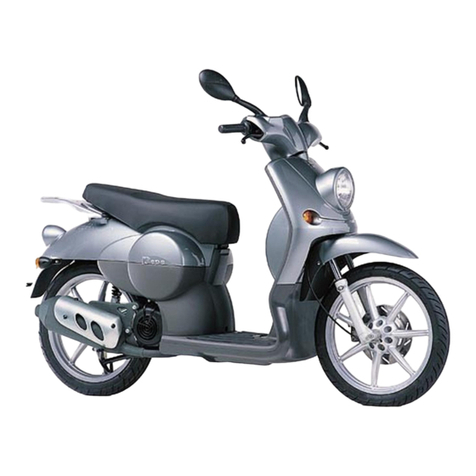
Benelli
Benelli Pepe Lx User manual

Benelli
Benelli Hornet Manual
